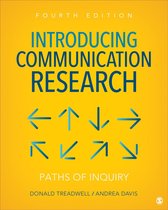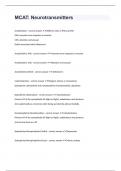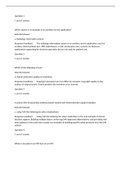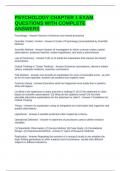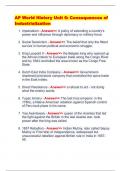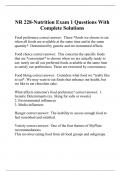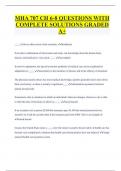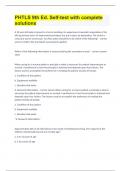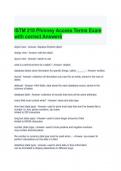Introducing Communication Research
Methodology Tilburg University (lectures, book and articles)
Week 1 - Introduction lecture
Scientific research
➔ Starts with an interest in or question about phenomena, situations, or behavior
● Research questions can be of all kinds
➔ Finds out what’s already known about the topic
● Literature review
➔ Provides its own attempt to describe or explain the phenomenon/situation/behavior or tests
and existing description/explanation
● Multiple ways of approaching a description/explanations (“worldviews”/“epistemologies”)
➔ May use various types of data to do so
● Different types of research methods (usually tied to the choice of
worldview/epistemology)
Question: When should we believe an explanation/description?
● Only if the research is reliable
● Only if the research is valid
● Always provisionally (someone might come up with a better explanation)
Week 2 - starting points of research
Foundations and starting points
Worldview = a basic set of beliefs that underpin our perspectives on communication research.
People have different takes on what the purpose of research should be, which shapes their
approaches. Being aware of your own worldview allows you to refine your research questions.
Worldview 1: nomothetic approach [Greek. nomos = law, thétes = one who establishes]
➔ Human behavior = predictable, objectively measurable, generalizable and motivated by
events, personality and other people.
➔ Understanding behavior is best done by isolating factors and seeing what happens
➔ mostly quantitative research methods
Worldview 2: idiographic approach [idios = own, private, graphein = to write]
➔ Each person is unique, unpredictable, and self-motivated.
➔ Understanding behavior is best done from the participant’s perspective and by considering
the whole situation.
➔ mostly qualitative research methods
, 2
In reality almost all researchers believe that some elements are predictable and at the same time
that each one of us is unique (with unique aspects)
Example study worldview 1: effects of task complexity on writing accuracy in a foreign language
Experiment: participants were instructed to write a letter to a friend, about choosing the right
destination for their holiday
● Half of them had to make an easy choice (three options, one best)
● Half of them had to make a difficult choice (five options, none ideal)
Outcome: the letters written in the ‘difficult’ condition contained fewer errors!
This approach is:
➔ Hypothesis-based
➔ Systematic manipulation
➔ Clear causal relation
➔ Generalizable result
Example study worldview 2: group formation in a diverse classroom
● Observation study: researcher joined a class of 6-year-olds for a month and watched the
children play, learn, discuss etc.
Outcome: group formation is discussed explicitly and manifests itself in behavior in many different
ways. This approach is:
➔ Data-driven approach
➔ Real communicative setting
➔ Diverse set of observations
Other worldviews
Creswell and Creswell (2018) identify four worldviews, as follows:
(1) Postpositive
➔ challenges absolute truth, emphasizing cause and effect
➔ relies on laws or theories that can be tested or verified
➔ big ideas are reduced to sets of data that allow hypothesis testing
➔ theory leads to data collection and testing of the theory using quantitative methods.
➔ objective observation and measurement.
(2) Constructivist
➔ individuals seek understanding of the world and construct their own views of it
➔ researchers rely on participants’ own, subjective views of the world and
➔ use qualitative methods to capture them
➔ research is interpretive and qualitative, moving from observation to theory development.
, 3
(3) Transformative
➔ change-oriented
➔ argues for mixing research with politics to confront social oppression and change lives
for the better.
➔ basic interest in the marginalized and disenfranchised
➔ embraces a variety of research interests, including action research and critical analyses
(4) Pragmatism
➔ focuses on solutions to problems - what works - and using all possible approaches to
understanding these problems
➔ does not commit to one basic philosophy > embraces mixed-method research
➔ “real world”/practice oriented with a focus on the problem rather than research method
➔ Research decisions are based on what the researchers want to do with their
research—on why they are doing.
Research methods
Quantitative Qualitative
human traits and behaviors can be translated human traits and behaviors are best
into numbers to analyze them. understood by observing and interviewing
people
e.g. how much/many (why, reasons, beliefs, experiences).
[how to quantify it, passing grades, e.g.] e.g. RQ: what makes people behave like [x],
cause - effect why do people act like [x]
(experiment: does X lead to why, what is the
effect of X on Y).
Typically quantitative methods: Typically quantitative methods:
● Experiments ● Interviews
● Surveys ● Focus groups
● Content analysis ● Case studies
● (Meta-analysis) ● Observational studies
● (Computational ● Diary studies
● modeling)
Triangulation: the act of combining research methods to neutralize the weaknesses of single
research methods.
WEIRD biases: describes a lack of diversity in research. WEIRD stands for Western, Educated,
Industrialized, Rich, and Democratic
, 4
Three thought processes that link observations with theories
1. Deduction: you know the rule (theory), as well as the cause. Therefore, you can deduce
the effect.
2. Induction: given a cause and an effect (pattern), you can induce a rule (theory).
3. Abduction: Given a rule and an effect, you can abduce a cause.
Deducation Induction Abduction
(theory, hypothesis testing) (theory building, hypothesis
generation)
General rule Specific observation Incomplete observation
Rule (theory): all men are Cause (hypothesis): socrates is a Rule (theory): all men are mortal
mortal man
Cause (hypothesis): socrates Effect (result): socrates is mortal Effect (result): socrates is mortal
is a man
Effect (result): socrates is Rule (theory): all men are mortal Cause (hypothesis): socrates is a
mortal man
Specific conclusion: General conclusion: may be Best prediction: may be true
always true true
e.g. if violent video games e.g. Bobby hit his brother after All swans are white (theory),
cause aggression, gamers he played Grand Theft Auto. Daisy is white (result), therefore
will, on average, have a Therefore, violent video games daisy is a swan (hypothesis)
higher incidence of cause aggression.
committing violent acts than
non-gamers. (or: bobby will
be more likely to hit his
brother than Bobby’s
non-gamer friend)
Empirical cycle
➔ theory
➔ hypothesis
➔ observation
➔ analysis
➔ interpretation

